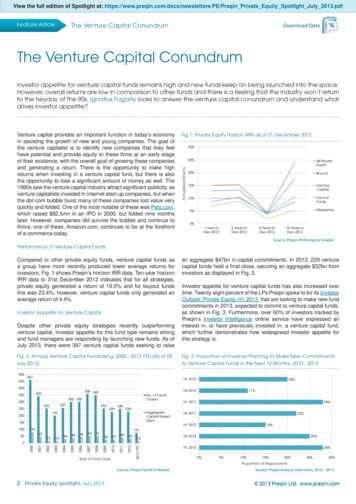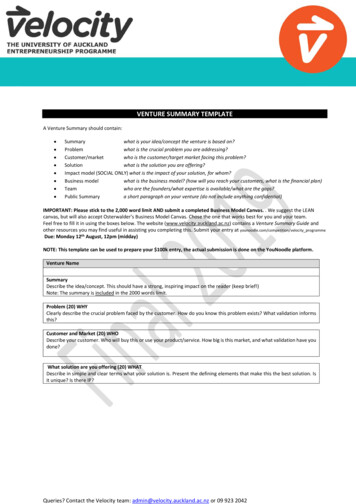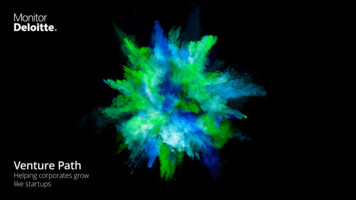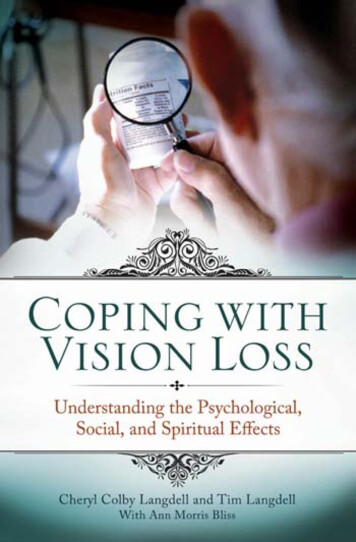
Transcription
The blindness of venture capitalReading Project in MVE220, Financial Risk.All group members have contributed equally to this project.Grochevaia, Nadjanadejda@student.chalmers.seLiu, Jerrylijerry@student.chalmers.seMay 10, 2019
Contents1 Background1.1 Elizabeth Holmes . . . . . . . . . . . . . . . . . . . . . . . . . . . . . . .112 Funding2.1 Investment Case . . . . . . . . . . . . . . . . . . . . . . . . . . . . . . . .2.2 People . . . . . . . . . . . . . . . . . . . . . . . . . . . . . . . . . . . . .2223 Financial Time Line34 Debunking4.1 Capillary blood contents . . .4.2 The problem of the innovation4.3 FDA . . . . . . . . . . . . . .4.4 Secrecy . . . . . . . . . . . . .334555 The fall5.1 Wall Street Journal . . . . . . . . . . . . . . . . . . . . . . . . . . . . . .566 Summary67 References78 Further Reading8.2.
IntroductionThis essay gives a brief introduction to the rapid rise and fall of the healthcare technologycompany Theranos: a privately held multi-billion dollar medtech startup that managedto obtain a 9 billion dollar valuation at its height, followed by an inevitable bankruptcytwo years later. Our goal is to investigate the intricacies behind the plot that enabledTheranos to achieve such a high valuation without having a working product to show for,while at the same time endangering the lives of innocent people. We will also discuss thepotential upside and pitfalls of venture capital.1BackgroundTheranos was founded in 2003 by ElizabethHolmes, who at the time was 19 years old. Froman early age, she had a vision of one day changing the world; a dream of a new technology thatcould perform advanced laboratory analysis on atiny amount of blood, in the convenience of yourhome and at a fraction of the cost. This revolutionary healthcare innovation was inspired byHolmes’ inherent fear of needles and the tragicloss of her uncle, the latter being greatly exaggerated as a key component of the image she triedto purvey[1].1.1Elizabeth HolmesThe founder and former CEO of Theranos, Elizabeth Holmes, was born in 1984. Holmesknew at a very young age that she wanted to become a billionaire. Her innovative naturecompelled her to pursue the field of science; she even tried to build her own time machineat the age of seven. In 2002, during an internship at the Genome Institute of Singapore,Holmes spawned the idea for Theranos and a year later, she filed a U.S. patent for herso called "drug delivery and adjusting dosage system". In 2004, Holmes left Stanfordto start her own company, then called Real-Time Cures, and changed the description ofher patent to "portable blood testing device", later named Edison. Around that time, anew company name came about: the amalgamation between "therapy" and "diagnosis",which ultimately became Theranos. During Holmes’ years as CEO, she became incrediblyfamous, hosting multiple talks and was featured in dozens of magazines. It was also atthis point in time when Holmes’ obsession with Steve Jobs became glaringly apparent;she started to mimic the Silicon Valley megastar in every aspect of life, from clothing tomanaging style, and even the manner he carried himself. In 2014, Holmes took a spot onthe Forbes list of the 400 richest Americans and was dubbed the world’s youngest selfmade female billionaire and genious. Shortly after, Holmes and Theranos was chargedwith fraud for drastically overstating the company’s medical testing technology. Followingthese events, Holmes settled and relinquished control of Theranos in 2018 [1].1
2FundingFor the idea to become reality, Elizabeth Holmes was in need of backers and capital, andwhere else in the world could you find such risk-willing appetite for college dropouts,other than Silicon Valley. Back in 2003, during the inception of the company, Theranos’primary source of funding was from family members and friends. Holmes managed topersuade a celebrity attorney, two former secretaries of state and the ex-CEO of WellsFargo to join the company, all of whom were appointed to serve on the board. Theseindividuals in turn used their influence to recruit other wealthy investors. The Theranosinvestor list consisted of university alumni and distinguished military veterans, fromwhom Holmes received 700 million dollars in funding. The money, on the other hand,was never reported in any financial statements, since Holmes never hired any accountantsto produce audited financial information.This begs the question: how was this possible? It seems that nobody really has a goodanswer, but most people agree that Holmes had charisma, outstanding networking skillsand an intelligent demeanour; qualities which helped her to quickly raise seed money forTheranos. Despite Holmes’ clear display of leadership, some large venture capitalists werestill hesitant towards investing in Theranos, due to her unwillingness to share informationabout the technology and the lack of support from the scientific community via peerreviewed research. Also, the members of the board lacked both medical and scienceexperience. The secrecy behind Edison was a key component that made this grand fraudpossible. Holmes acquired talented engineers and forced them into strict non-disclosureagreements. She even kept the employees isolated from each other, in order to preventinformation leakage, and critics who disputed the product were immediately fired[2].2.1Investment CaseIn a graph published by the Wall Street Journal in 2014the U.S. medical laboratory revenue was estimated to be 31.1B. An attractive market that Theranos wanted to bea part of. The goal of the company was to introduce theuser-friendly and affordable Edison machines into drugstores and pharmacies around the U.S. for the purpose ofcapturing market shares. The appeal was that the Edison machine could perform a large number of blood testsat more convenient locations. Previously, these test wereonly available in expensive hospital laboratories.2.2PeopleWhen investing in a company one tend to look at its structure as well as the members ofthe board. In Theranos’ case it was the 19-year-old Stanford dropout, Elizabeth Holmes,who dressed solely in black turtlenecks with a burning passion to disrupt the status quo.A common back story for some of the biggest names in Silicon Valley: Bill Gates, MarkZuckerberg and Steve Jobs, the latter whom obviously inspired Holmes’ sense of fashion.For some investors it was reasonable to invest millions of dollars in a product that lacked2
scientific support, but it is most likely a risk you are willing to take when you fantasizeof even greater revenue.3Financial Time LineSince foundation in 2003, Theranos got through its first round of funding in 2004 withan valuation of 30 million. From early on Elizabeth was able to secure well-known people such as Henry Kissinger, Betsy DeVos, and Rupert Murdoch on the board. Havingacquired the former U.S. Secretary of State on the list of investors meant that the company’s credibility grew immensely in the public eye. This lead to Theranos achieving avaluation of almost 200 million after raising 43 million in capital in 2007. Three yearslater the company was valuated at 1 billion after further rounds of funding[3].In 2013 Elizabeth Holmes announced Theranos to the world and unveiled their website.A year later with over 400 million in funding the company was valuated at 9 billiondollars. In the following two years, the company lost two of its big partners and all of itsrights, an event we will investigate and also how one as an investor could have navigatedthis better.4DebunkingWhen investing in ideas and promising startups, one tend to think of the possibilitiesand not the limitations. What Theranos promised was a majorly disruptive technologywith massive implications on the current way of blood testing. In hindsight, it is notdifficult to see the red flags and realize where it all went wrong. Although, at the timeit might not have been that obvious. According to interviews with former employees,the company had specific routines in place totrick investors on their visits. Theranos employeeswould take blood samples from investors and runthem on third-party machines, whilst taking themon guided tours, and nobody suspected anythingsince the test results were consistently accurate[4].4.1Capillary blood contentsThe early focus of the company was runningtests on minuscule amounts of blood from fingersticks. But problem with that was primarily performance; it is virtually impossible to perform alarge number of tests on an insignificant amountof blood. Since there are only a finite number ofblood cells in a single drop of blood, the probability of detecting certain diseases diminishes due tothe sample size i.e. one cannot simply extract enough infected cells from a sample thatsmall. The inaccuracy renders the test results useless. These fingerstick samples onlycontain capillary blood, which is a mixture of blood from arterioles, veins and capillaries3
and it contains some interstitial and intracellular fluid. These samples sufficed for certaintests like sugar level for diabetics but didn’t provide the accuracy obtained from largervenous samples. The small volume of capillary blood samples also makes it more exposedto contaminants in the results, reducing the accuracy further. Despite all this, the company still marketed their product of only requiring only droplets of blood in an advertreleased 2016. Their machine was supposedly able to handle up to 200 tests shown in thetest-sheet, a remarkable number of tests in a single machine with the size of an oven[5].4.2The problem of the innovationThe idea behind the user-friendly portable blood-testing device was not pioneered byHolmes and Theranos. In fact, years prior to the launch of Edison, innovations made byengineers within the field of microfluidics lead to the invention of a similar device butwith fewer selected tests. The limiting factor of the device was its overall size. The smallform factor exposes adjacent parts in the device to noise e.g. the spectrophotometerwas likely to interfere with theluminometer due to componentsbeing densely packed (see Figure). The Apple looking product wouldn’t work, where it wouldsometimes literally fall apart andthe regularisation of the temperature was persistently off. Theranos’ engineers tried to work outthe solutions but were fired whilementioning their concerns.Holmes’ overzealousness towardsher business endeavours, coupled with complete disregard of technical capabilities andscientifically sound solutions, lead Theranos to its inevitable demise. The managingdirectors at Theranos seemed ignorant of several basic limitations and believed that anyproblem could be resolved, in spite of efforts to explain the impossibility of the Edisonprototype from the employees. Another problem with Theranos business idea was thatdiagnostic blood test results were handed to patients directly without any reading frommedical professionals. Initially, it seemed like a well-thought-out idea, since there is alarge part of the population that do not have access to universal healthcare. However,the technology still lacked a user interface that would eliminate the need for analysis bya professional. In order to provide a full spectrum of care, diagnostics would have to becombined with an AI that take a patient’s medical record and current health status intoaccount, to produce an accurate reading. The health of an individual is not completelyreflected in the test; one have to take a contextual approach and try to understand towhat extent a person’s life choices affect the overall diagnosis.Despite all these complications, Holmes still managed to raise several billions in venturecapital and attain a highly profitable business contract with a well-established drugstorechain, Walgreens in the U.S. Unbeknownst to the general public, the inaccurate bloodtest results produced by Edison threatened the lives of countless patients[6].4
4.3FDAIn early 2015 Theranos received FDA approval on their machine for the test of herpessimplex virus - type 1 (HSV1)[7]. It’s a widely common virus with an estimated 3.7billion people under the age 50 being infected globally according to the World HealthOrganization[8]. The test relies on chemiluminescent immunoassay, a method based onenzyme labeled antibodies that breaks down the molecule which emits light in the process.Looking at what the approval itself says, although for a novel disease, could conveyssome information on what actually occurs inside the machine. One interpretation is thatTheranos have successfully built a machine capable of injecting a chemical into the sampleto then register the light emissions and process the data. This proves what the machineactually can accomplish, but it’s only one of the 200 tests advertised.Weirdly the launch to the public market occurred before the FDA approval as Walgreensrushed to open its’ first Theranos Wellness center in 2014[9]. While its’ competitorSafeway choose to keep the project on hold as the results were unsatisfactory. At the endof 2015 it will reveal that Safeway made the correct choice as complaints to the FDA andCMS started coming in from ex-employees. As the story unfolded, allegations arose thatthe only FDA approval Theranos received had actually been tampered with[10].4.4SecrecyAs common with disruptive start-ups Theranos wanted to keep their technology secret.This seems to be accepted to the investors, to a certain degree. In a almost comicallyvague quote from Elizabeth Holmes to the New Yorker in 2014 describing their machineshe said: "A chemistry is performed so that a chemical reaction occurs and generates asignal from the chemical interaction with the sample, which is translated into a result,which is then reviewed by certified laboratory personnel." This is the same year thatWalgreens opened their first Theranos wellness center[11].Two of the early big name brands that partned with Theranos was Safeway in 2011 andWalgreens in 2013. During their partnerships the two companies had opportunities tovisit Theranos head office and try out the machine, but never really got to see the machinein action as they were always taken to another room while Edison did the test. Safewayasked early on for tests of the Edison at their own facilities and received varying results,as one executive received results suggesting that he had prostate cancer but when thesample was sent to another lab for retesting the results returned normal[12].5The fallThe unravelling of the company began around 2015, when the lies and internal pressurestarted to boil over, disgrunted employees started talking with outside sources about whatreally went on inside of the company. After a disclosure article was published in WallStreet Journal, the largest investor of Theranos sold his shares to lowest possible priceeven taking tax losses. The U.S Securities and Exchange Commission charged Theranoswith fraud leading to the fall of the company. The fraud could have continued for yearsif it wasn’t for the whistle blower article in Wall Street Journal.5
5.1Wall Street JournalIn October 15, 2015 writer John Carreyrou released an scathing article criticizing Theranos. With the tips from ex-employees Carreyrou did some journalistic digging on theactual accuracy of the test results. By comparing blood-results from both Theranos anda hospital he found that Theranos often predicted much higher values than what thehospital did, leading to many of the values being out of the normal range and giving theimpression that the patient was sick when in fact the real test-values were completelynormal. Furthermore one former senior employee stated that only a small fraction of allthe tests were conducted on the "Edison machines", and that the majority of the testswere handled by competitors’ equipment, which would have been a violation of the U.S.Food and Drug Administration (FDA) rules[4].6SummaryThis story is another example of the "Fake it til’ you make it" attitude venerated bythe startup culture in Silicon Valley. It seemed like it didn’t even matter if you literallyplayed with people as long as it could end up with a possible successful device.So what could you as a venture capitalist actually have done? This investment caseseems to be very difficult to actually debunk, it had the eager college drop-out withan disruptive idea, multiple big name investors, like Henry Kissinger the former U.S.Secretary of State. The technology and application wasn’t too far fetched as the onlydraw-back with capillary blood tests is a low expected accuracy. All in all it really didn’tseem to be a bad investment case and could’ve potentially turned out to be somethingsuccessful with some other leadership.The only sign that could’ve tipped you off early was to maybe if you spoke with thepeople on the ground floor of the company, to actually talk to the employees and perhapssee what they have achieved or to study what the company are promising and comparingto what’s physically possible.The Theranos case is not over and trials are still proceeding, where the juridical decisionisn’t final yet. We’re still about to witness the final verdict of the Elizabeth Holmes, whichwill be published somewhere in the near future, but you can follow the development insources under Further reading chapter.6
7References[1] The Editors of Encyclopaedia Britannica- Elizabeth Holmes mes[2] Francine McKenna- The investors duped by the Theranos fraud never asked for oneimportant rs-duped-by-the-theranos-f[3] Zaw Thiha Tun - Theranos: Fallen ting/020116/theranos-fallen-unicorn.asp[4] John Carreyrou - Theranos Has Struggled With Its Blood-Test s-struggled-with-blood-tests-14[5] Barbara J. Bain et. al - Dacie and Lewise Practical Haematology 12th ed. (2017)ISBN: 978-0-7020-6696-2[6] Rachael Kraus- Theranos screwed up legit blood test innovations for -elizabeth-holmes-documentary?europe true[7] FDA 510(k) Substantial Equivalence Determination: Dsciosion Summaryhttps://www.accessdata.fda.gov/cdrh docs/reviews/K143236.pdf[8] WHO - Herpes Simplex ail/herpes-simplex-virus[9] John Carreyrou - Craving Growth, Walgreens Dismissed Its Doubts About h-walgreens-dismissed-its-dou[10] John Carreyrou - U.S. Probes Theranos theranos-complaints-1450663103[11] Ken Auletta - Blood 15/blood-simpler[12] Emily Wasserman - Safeway severs ties with Theranos as 350M deal lapses7
8Further Reading[1] Film by Alex Gibney. The inventor: Out for blood in silicon valley, 2019.[2] John Carreyrou. Theranos has struggled with its blood-test technology, 2015.[3] Rachel Kraus. Elizabeth holmes trial: What’s going on with the theranos founderafter ’the inventor’, 2019.[4] Tasha Robinson. The inventor examines the 9 billion theranos scandal, and blamessilicon valley, 2019.8
The blindness of venture capital Reading Project in MVE220, Financial Risk. All group members have contributed equally to this project. Grochevaia,Nadja










